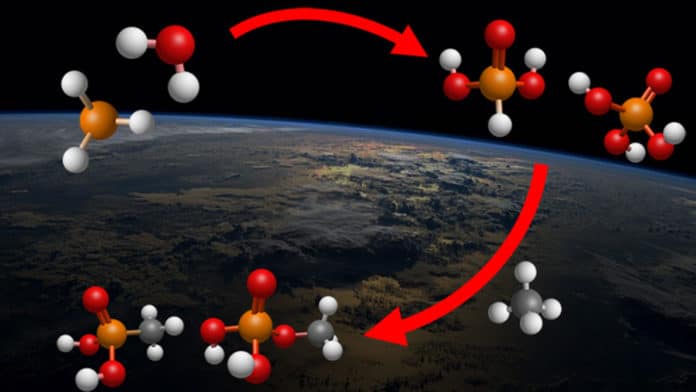For decades, the source of phosphorus incorporated into Earth’s first organisms has remained a fundamental, unsolved puzzle. Albeit contemporary biomolecules include P(+V) in their phosphate moieties, the limited bioavailability of phosphates prompted the proposal that more soluble P(+III) compounds served as the initial wellspring of phosphorus.
UH, Mānoa physical chemists in collaboration with colleagues from France and Taiwan have suggested that alkyl phosphonic acids, which are the only known phosphorus-containing organic compounds of extraterrestrial origin and were delivered to Earth on the Murchison meteorite, could have been the early source of soluble organic phosphorus available for Earth‘s first organisms.
Scientists used sophisticated laser-based detection techniques and identified newly formed molecules. They found that the alkylphosphonic acid can be produced in cold extraterrestrial ices that could eventually become incorporated into space debris such as meteorites and comets that fall to or impact on Earth.
That way for the alkyl phosphonic acid then became accessible for the first life on Earth. This is a crucial revelation as it associates the prebiotic origin of the element phosphorus back billions of years to ice in deep space.
Collaborator Cornelia Meinert (University of Nice, France) said, “It also provides a critical component for understanding the origin of life.”
The study highlights how alkyl phosphonic acids formed in icy space environments in deep space. During experiments, scientists created extraterrestrial model ice using phosphine, water, and methane—all molecules that have been identified in deep space—and subjected the ice to conditions that duplicate the temperatures and energy exposures in cold molecular clouds.
UH, Mānoa graduate students Andrew M. Turner said, “The present experiments critically advance our understanding how the only organophosphorus molecules detected in meteorites this far can be formed in deep space, thus constraining the molecular complexity of alkylphosphonic acids synthesized in low-temperature extraterrestrial ices.”
UH Mānoa chemistry Professor Ralf I. Kaiser said, “The identification of alkyl phosphonic acids in the present study suggests that even more complex phosphorus-bearing bio relevant molecules linked to the origin of life might be formed in interstellar ices.”
Other co-authors of the study include UH Mānoa graduate students Matthew Abplanalp and postdoctoral fellows Alexandre Bergantini, Robert Frigge and Cheng Zhu, and UH Mānoa chemistry Professor Ralf I. Kaiser.
The study is published in the journal of Science Advances.
